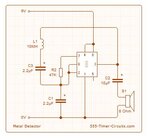human304
Newbie level 6

Hello everyone. I am designing a simple metal detector using the 555 timer. This is the link:
https://www.555-timer-circuits.com/metal-detector.html

However the sensitivity is very poor. How can i increase the sensitivity of the detector.
https://www.555-timer-circuits.com/metal-detector.html

However the sensitivity is very poor. How can i increase the sensitivity of the detector.
Last edited:

